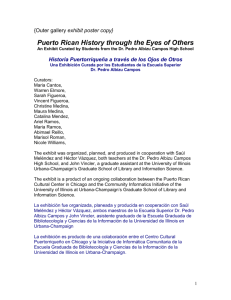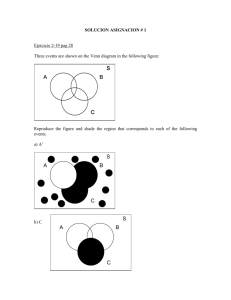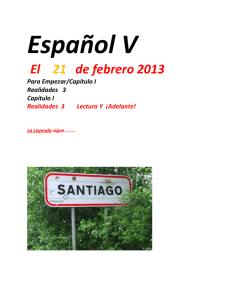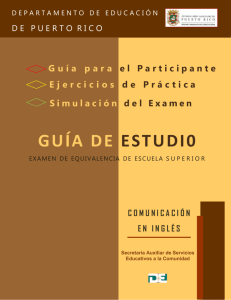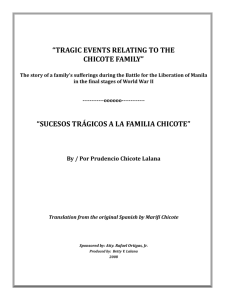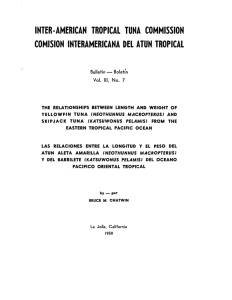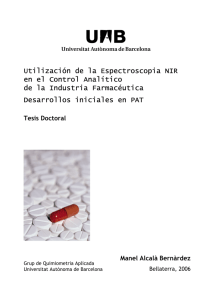Natural microorganisms of the fresh coffee pulp
advertisement
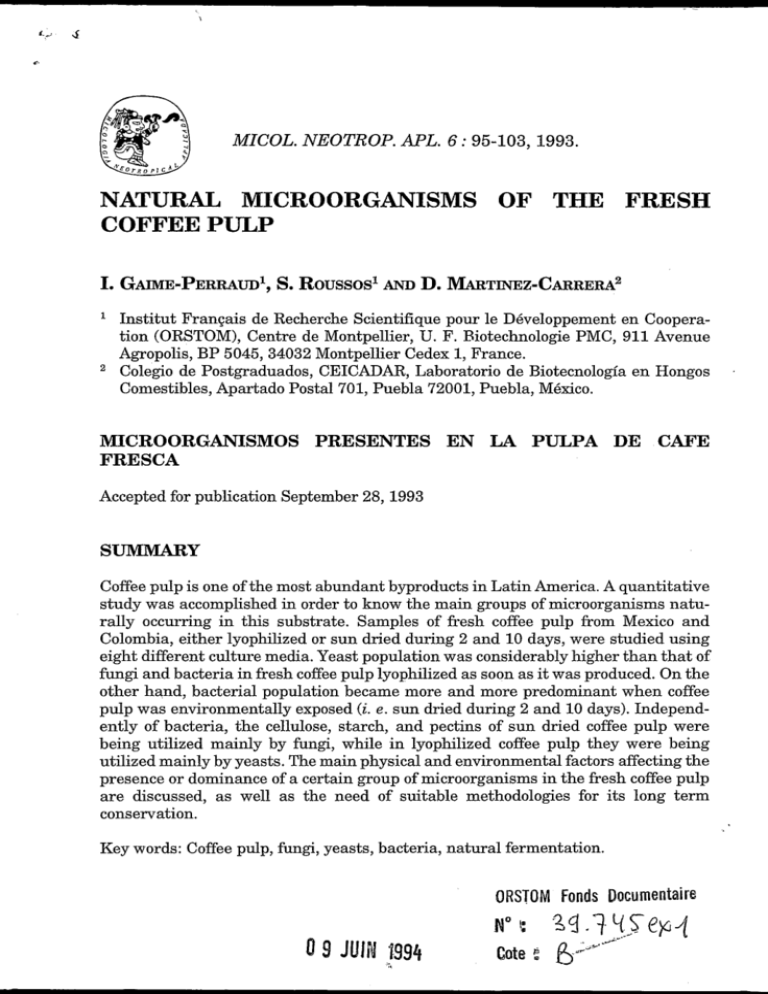
MICOL. NEOTROP. APL.6 :95-103,1993. NATURAL MICROORGANISMS OF THE FRESH COFFEE PULP I. GAIME-PERRATJD~, S. ROUSSOS~ AND D. MARTINEZ- CARRERA^ Institut Français de Recherche Scientifique pour le Développement en Cooperation (ORSTOM), Centre de Montpellier, U. F. Riotechnologie PMC, 911 Avenue Agropolis, BP 5045,34032 Montpellier Cedex 1, France. Colegio de Postgraduados, CEICADAR, Laboratorio de Biotecnologia en Hongos Comestibles, Apartado Postal 701, Puebla 72001, Puebla, México. MIGROORGANISMOS PRESENTES EN LA PULPA DE CAFE FRESCA Accepted for publication September 28,1993 Coffee pulp is one of the most abundant byproducts in Latin America. A quantitative study was accomplished in order t o know the main groups of microorganisms naturally occurring in this substrate. Samples of fresh coffee pulp from Mexico and Colombia, either lyophilized or sun dried during 2 and 10 days, were studied using eight different culture media. Yeast population was considerably higher than that of fungi and bacteria in fresh coffee pulp lyophilized as soon as it was produced. On the other hand, bacterial population became more and more predominant when coffee pulp was environmentally exposed (i. e . sun dried during 2 and 10 days). Independently of bacteria, the cellulose, starch, and pectins of sun dried coffee pulp were being utilized mainly by fungi, while in lyophilized coffee pulp they were being utilized mainly by yeasts. The main physical and environmental factors affecting the presence or dominance of a certain group of microorganisms in the fresh coffee pulp are discussed, as well as the need of suitable methodologies for its long term conservation. Key words: Coffee pulp, fungi, yeasts, bacteria, natural fermentation. 96 I. GAIME-PERMUD ETU. RESUR/IEN La pulpa de café es uno de los subproductos agrícolas más abundantes en Latinoamérica. Se llevó a cabo un estudio cuantitativo para conocer los principales grupos de microorganismos que se desarrollan en forma natural en la pulpa de café de México y Colombia. Se estudiaron muestras de pulpa de c d é fresca liofilizada y secada al sol durante 2 y 10 días, empleando 8 medios de cultivo diferentes. La población de levaduras fue considerablemente más alta que aquella de hongos y bacterias en la pulpa de café fresca que se liofilizó una vez obtenida. En cambio, la población bacteriana fue cada vez más predominante en la pulpa de café que permaneció expuesta, es decir, cuando se secó al sol durante 2 y 10 días. Independientemente de las bacterias, la celulosa, el almidón y las pectinas de la pulpa de café secada al sol estaban siendo utilizadas principalmente por hongos, mientras que en la pulpa liofilizada principalmente por levaduras. Se discuten los principales factores que afectan la presencia o dominancia de cierto grupo de microorganismos en la pulpa de café fresca, así como la necesidad de métodos adecuados para su conservación a largo plazo. Palabras clave: Pulpa de café, hongos, levaduras, bacterias, fermentación natural. INTRODUCTION Commercial coffee production is an economically important activity in most Latin American countries. As the world trade market of coffee grain is now being collapsed and fetching very low prices, there is a pressing necessity for using the coffee byproducts profitably. Coffee pulp is the most important byproduct of the so called wet coffee processing, as it represents about 40% of the fruit on a fresh weight basis (Tauk, 1986), and 29% on a dry weight basis (Bressani et al., 1972). It has been calculated that nearly 2,500,000 tons of fresh coffee pulp are produced around the world each year (Roussos et al., 1989), most of which remain unused so far causing serious pollution problems. Several alternatives have been proposed for the utilization of coffee pulp, such as animal feed, organic fertilizer, or as a substrate for enzyme production (Antier et al., 1993; Boccas et al., 1993), for biogas production, for edible mushroom production (Martinez-Carrera, 1989), and for vermiculture (Bouché, 1991). However, the practical application of these technologies has been difficult because a high moisture content (8045%) and the presence of many other nutrients, easily available for a wide variety of microorganisms, MICROORGANISMS OF COFFEE PULP 97 make the fresh coffee pulp a substrate of very difficult handling and iong term conservation. In this work, a quantitative study was performed in order to know the main groups of microorganisms naturally occurring in the fresh coffee pulp with different treatments from Mexico and Colombia. MATERIALS AND METHODS Substrates Three samples of fresh coffee pulp were obtained by the wet coffee processing from Mexico and Colombia. Sample A was coffee pulp sun dried during 10 days and collected in Xalapa, Veracruz, Mexico, with a moisture content of about 10%. Sample B was coffee pulp sun dried during 2 days and cdllected in Chinchina, Caldas, Colombia, with a moisture content of about 10%. Sample C was lyophilized cpffee pulp also collected in Chinchina, with a moisture content of about 5%.All samples were stored in plastic bags under humidity controlled conditions. Microbiological analysis Culture media. Sterilization was accomplished by autoclaving at 121°C for 15 min. Three different culture media were used for determining the main groups of microorganisms. Potato dextrose agar (Difco) was used for fungi and prepared by adding 0.250 g L-l chloramphenicol as antibiotic (PDA + A), the final pH was adjusted to 5.6. Sabouraud dextrose agar (Difco) was used for yeasts and also prepared by adding 0.250 g L-l chloramphenicol ( S A B + A), with a final pH of 5.6. Plate count agar (PCA, Difco) was used for bacteria and had a final pH of 7.0. Four selective culture media were used for studying microorganisms (bacteria were not studied), according to their nutritional requirements. 1) Cellulose group. Medium of Mandels and Weber (1969) whose composition was (g L-I): (NH,),SO, 1.4, KH,PO, 2.0, urea 0.3, CaC1,.2H,O 0.3, MgS04.7H,0 0.3, Carboxy-methyl cellulose 2.0, Tween 80 (1ml L-l), yeast extract 0.25, peptone 0.25, FeS04.7H,0 0.005, MnS04.7H,0 0.00156, ZnS0,.7H,O 0.00140, CoCl, 0.002, agar 15.2) Starch group. The composition of the agar medium was (g L-l): starch 2, urea 0.05, (NH,),SO, 0.15, agar 15. 3) Pectin group. The composition of the agar medium was (g L-9: citric pectin 98 I. GAIME-PERRAKD ET AL. (SIGMA) 2, urea 0.05, (NH,),SO, 0.15, agar 20 (Boccas et al., 1993). 4)Lactic group. The culture medium was prepared by adding'l5 g L-l agar to the Lactobacilli MRS broth (Difco), and adjusting the final pH to 6.5. 4 The culture medium based on coffee pulp extract was prephred as follows: 40 g of coffee pulp are ground and boiled in 1L distilled water during 10 min. This solution is filtered (filter paper Whatman No. l), adjusted to 1L, and mixed with (g L-l): KH,PO, 1.3, Na,HPO, 0.12, MgSO, 0.3, CaC1, 0.3, and agar 15. Bacteria were not studied in this medium. Inoculation. 10 g of coffee pulp from each sample studied were ground and mixed with 90 ml sterile distilled water and 0.1 ml of Tween 80. This solution was homogenized in Ultra-Turrax at maximum speed during 4 min..Eight dilutions were prepared from the homogenized solution. The optimal dilutions were selected by inoculating a microdroplet of each dilution on 2 petri dishes of every culture medium (eight microdroplets per petri dish); as can be seen in figure 1, which were incubated at 28°C. Subsequently, for the final counting of microorganisms, 0.1 ml of the selected dilutions were again inoculated and homogeneously distributed on petri dishes of all culture media (3 replicates, 28OC). Microorganisms were identified under the microscope. 10-1 10-7 10-5 Fig. I. Method of inoculation of a microdroplet in petri dishes used in this study for selecting optimal dilutions in different culture media. MICROORGAN~MS OF COFFEE PULP 99 RESULTS AND DISCUSSION Bacteria, fungi and yeasts were the main groups of microorganisms found growing in all studied samples of coffee pulp. The number of microorganisms varied according to each sample (Table 1).The population of bacteria in samples A (98.8%)and B (94.7%) was considerably higher than that fQund in sample C (37.0%). Conversely, the population of yeasts was considerably higher in sample C (60.6%)than in samples A (0.1%) and B (1.2%). There was not a significant variation among the three samples with regard to the fungal population. Accordingly, it can be said that the fresh coffee pulp is particularly rich in yeasts and bacteria, as sample C was directly lyophilized as soon Table 1.Main groups of microorganisms which occur naturally on fresh coffee pulp with different treatments, in comparison with other tropical substrates. Substrate Sample (Country) Microorganisms (%)* 1 Fungi Yeasts Bacteria - ' Total Sun dried coffee pulp A (Mexico) 1.24x106(1.1) 1.O7x1O5(0.1) l . l l ~ l O ~ ( 9 8 . 8 )1 . 1 2 ~ 1 0 ~ Sun dried coffee pulp B 2 .85x104(4.1). 8.52x103(1.2) 6.64x105(94.7) Lyophilized coffee pulp C 8.56x104(2.4) 2.18x1O6(6O.6) 1.33x1O6(37.O) 3 . 6 0 ~ 1 0 ~ (Colombia) Sugar cane bagasse** .\ 7.O 1 ~ 1 0 ~ (Colombia) 1.08x104 2.63~10~ Cassava meal*** * Number of microorganisms per gram of dry weight substrate. ** Data from Roussos (1985). *** Data from Raimbault (1980). 2.64~10~ 2.50~10~ . P 100 I. GAIME-PER” ET AL. as the pulp was produced. However, the bacterial population becomes predominant when the coffee pulp is environmentally exposed; this was the case of samples A and B, which remained exposed to be sun dried during 10 and 2 days, respectively. In comparison with other tropical substrates, such as sugar cane bagasse and cassava meal, the colffee pulp showed a relatively high number of total microorganisms (Table 1). The number of fungi and yeasts from the samples studied grown on different selective media is shown in Table 2. Independently of bacteria, it can be seen that cellulose, starch and pectins are being utilized mainly by fungi in samples A and B, while mainly by yeasts in sample C. In the case of lactics, there were no fungi or yeasts d’egrading them in samples A and B, which Table 2. Fungi and yeasts from fresh coffee pulp grown on selective culture media and grouped according to their nutritional requirements. Group Sample (Country) Microorganisms* . Yeasts Fungi ~ ~~ ~ ~ ~ ~~ ~ Cellulose A (Mexico) B (Colombia) C (Colombia) - 8.33~10~ 2.59~10~ 6.25~10~ 4.41~10~ 9.63~10~ 2.18x106 Starch A (Mexico) B (Colombia) C (Colombia) 5.67~10~ 1.57~10~ 5.26~10~ 6.67~10~ 3.70~10~ 2.60~10~ Pectin A (Mexico) B (Colombia) C (Colombia) 8.43~10~ 2.17~10~ 5.16x104 2.04~10~ 3.89~10~ 1.89~10~ Lactic A (Mexico) B (Colombia) C (Colombia) 0.0 0.0 0.0 0.0 0.0 6.02~10~ * Number of microorganisms pes gram of dry weight substrate. MICROORGANISMS OF COFFEE PULP 101 could mean that bacteria are mainly involved in this process; on the other hand, a good number of yeasts were counted from sample C in this medium. The number of fungi and yeasts found in the culture medium based on coffee pulp extract can be seen in Table 3. Fungi were more abundant than yeasts in samples A and B, while a higher population of yeasts was found in sample C. Coffee pulp is a byproduct very rich in nutrients, which can be immediatly used in nature by a number of microorganisms. The presence or dominance of a certain group will depend on many physical and environmental factors, which can be summarized in figure 2. Natural fermentation develops rapidly and can take different pathways (e.g. acetic, lactic, anaerobic, aerobic). These microorganisms can be beneficial or even harmful if the coffee pulp is used as a substrate for other purposes, e.g. edible mushroom cultivation (MartínezCarrera, 1987). If any of the available technologies for using the coffee pulp is to be applied on a local or regional basis, the following aspects shoud be considered: 1) Plant variety and quality of the fruit, 2) Method of coffee processing, either “wet” or “dry”, considering the water quality used in the process, 3) Management of the coffee pulp after discarding, 4)Environmental conditions (temperature, humidity) in which the coffee pulp is being Table 3. Microorganisms counted from the culture medium based on coffee pulp extract. Sample (Country) Microorganisms“ Fungi A (Mexico) B (Colombia) C (Colombia) * Number of microorganisms per gram of dry weight substrate. Yeasts 102 I. GAIME-PERRAUD ET AL. ENVIRONMENTAL CONDITIONS OF THE FRUIT METHOD OF COFFEE PROCESSING I MANAGEMENT AFTER DISCARDING Fig. 2. Different factors affecting the natural microorganisms growing on coffee PulP. produced, and 5) Quantity and quality of coffee pulp currently produced. Each one of these factors, independently or as a whole, are responsible for the heterogeneity of coffee pulp and directly affect its quality as a raw material. Accordingly, suitable methods of long term conservation of this substrate are needed. ACKNOWLEDGEMENTS The authors thank Mme. Laure Hannibal for her excellent technical assistance. Dr. Jaime Zuluaga, CENICAFE, kindly provided coffee pulp samples from Colombia. LITERATCTRE CITED ANTIER, P., A. MINJARES, S. ROUSSOS, M. RAIMBAULT and G.VINIEGRAGONZALEZ, 1993. Pectinase hyperproducing mutants of Aspergill us niger C28B25 for solid state fermentation of coffee pulp. Enzyme Microb. Technol. 15: 1-17. MICROORGANISMS OF COFFEE PULP 103 BOCCAS, F., S . ROUSSOS, M. GUTIERREZ, L. SERRANO and G. VINIEGRAGONZALEZ, 1993. Fungal strain selection for pectinases production from coffee pulp in solid state fermentation system. J. Fd. Sci. Technol. 30: in press. BOUCHE, M., 1991. La lombricultura en el tratamiento de residuos orgánicos. 2nd. Inter. Symp. on Biotechnology in the Coffee Industry, Manizales, Colombia. BRESSANI, R., E. ESTRADA and R. JARQUIN, 1972. Pulpa y pergamino de café, I. Composición química y contenido de aminoácidos de la proteína de la pulpa. Turrialba 22: 299-304. MANDELS, M. and J. WEBER, 1969. The production of cellulases. Adv. Chem. Ser. 95: 391-414. MARTINEZ-CARRERA, D., 1987. Design of a mushroom farm for growing PZeurotus on coffee pulp. Mushroom Journal for the Tropics 7: 13-23. MARTINEZ-CARRERA, D., 1989. Simple technology t o cultivate Pleurotus on coffee pulp in the tropics. Muslaroom Science 12(II): 169-178. RAIMBAULT, M., 1980. Fermentation en milieu solide. Croissance de champignons filamenteux sur substrat amylacé. Thèse de Doctorat d'Etat. Sciences Naturelles (Université Paul Sabatier), Toulouse, France. ROUSSOS, S., 1985. Croissance de Trichoderma harzianum par fermentation en milieu solide: physiologie, sporulation et production de cellulases. Etudes et Thèses (Université de Provence), ORSTOM, Paris. ROUSSOS, S.,A. AQUIAHUATL, J. CASSAIGNE, E. FAVELA, M. GUTIERREZ, L. HANNIBAL, S . HUERTA, G. NAVA, M. RAIMBAULT, W. RODRIGUEZ, cT. A. SALAS, R. SANCHEZ, M. TREJO and G. VINIEGRA-GONZALEZ, 1989. Detoxificación de la pulpa de café por fermentación sólida. 1st. Inter. Symp. on Biotechnology in Coffee Industry, Xalapa, Mexico. TAUK, S. M., 1986. Estudo decomposiçao da polpa de café a 45°C atraves do uso de microorganismos isolados da polpa. Turrialba 136: 271-280.

